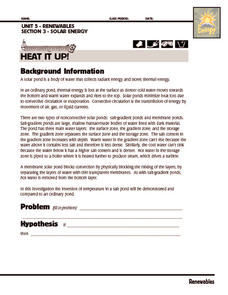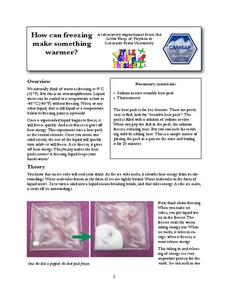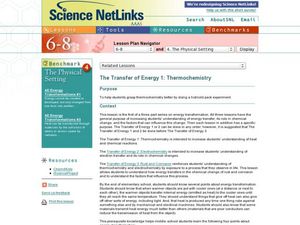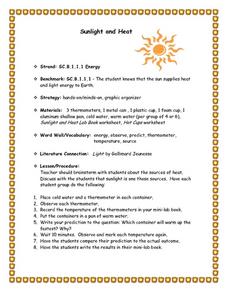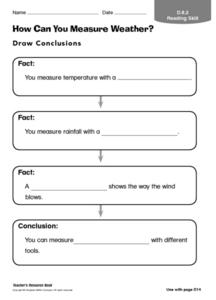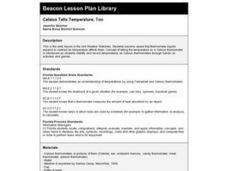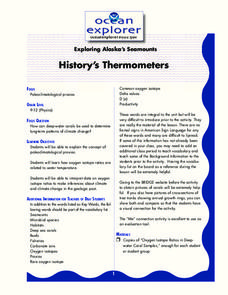02 x 02 Worksheets
Measuring Length
Your young forensic scientists add to and strengthen their measurement and conversion skills with these seven well-scaffold worksheets. Metric conversions, measuring length, area, and volume, reading thermometers, graduated cylinders,...
Curated OER
Going to the Doctor: Vocabulary Cards
Flash cards are a great tool for kids with autism; use them to build a functional vocabulary. This set of nine flash cards focus in on vocabulary you'd use at the doctor's office. Consider providing sentence frames for your...
Curated OER
Do the Tallywalker
Students study the basics of mapmaking, then make a tally walker, (geographic location device used in secret).
Curated OER
Sorting
Learners examine Library organization. In this logic lesson, students watch a Between the Lions episode and consider how the library has been organized. Learners each list their 3 favorite book titles and how they would classify them....
Texas State Energy Conservation Office
Investigation: Heat it Up!
This demonstration of solar ponds can be used in an earth, environmental, or physical science setting. Lab groups set up a solar pond and model how it is able, due to a salt concentration gradient, to maintain heat for future use.
PBS
Adding Integers
Your sixth and seventh graders deepen their understanding of a number line and adding integers in this concrete, hands-on activity. Learners play "Warehouse Puzzle" and then discuss their game strategies and the characteristics...
Virginia Department of Education
The Law of Conservation of Matter
The Law of Conservation of Matter can be complex for young scientists to fully grasp. Use this experiment to help simplify the process as pupils perform two experiments to determine mass: one that melts a substance and the other that...
Balanced Assessment
Pen Pals
It's always nice to hear from friends. Your budding mathematicians read letters from pen pals and convert customary measurements into metric units and vice versa. They also write letters to an imaginary pen pal using metric units.
Colorado State University
How Can Freezing Make Something Warmer?
Crazy fact—freezing liquid actually gives off heat! Young scholars investigate the transfer of energy when liquids freeze using a chemical heat pack. The heat pack gives off heat as its liquid core freezes.
Curated OER
Blubber Mittens:Adaptation to Cold Climates
Students get a first hand look at the benefit of a "blubber layer" in cold climates through a simulation using vegetable shortening and icy water. Through this simulation, students examine how adaptations help organisms survive.
Curated OER
The Transfer of Energy 1: Thermochemistry
Budding chemists achieve a basic understanding of the role of heat in chemical reactions. An online worksheet gives learners instructions and questions to answer as they investigate the Chem4Kids website and perform a hands-on lab...
Curated OER
World of the Pond
Field trip! The class will review what they know about organisms that dwell in freshwater ponds, then trek down to the old water hole to collect specimens for examination. This includes several web links, useful tips, and an excellent...
Science Matters
Blubber Gloves: It’s All About Insulation
Instill the concept of adaptation with the help of Blubber Gloves—ziplock bags, shortening, and duct tape. Scholars discuss how animals and plants keep warm in polar regions, record their predictions, and try on their Blubber Gloves to...
Curated OER
Thermometers Rising
Third graders read a Fahrenheit thermometer from an actual thermometer. In groups, they are provided with ink pads and a thermometer stamp. They use the stamps on plain white paper and use red pencil to take the temperature readings.
Curated OER
Keeping Cool
Students investigate the air conditioner units around the school. They chart the temperature by placing a thermometer in different situations and decide how to keep cool and save energy in the summer.
Curated OER
Fahrenheit vs Celsius
Students make a thermometer and write a paragraph about how they did it.
Curated OER
Computer Science: Temperature
Students conduct an experiment on heat transfer and how it works. They record the temperature in whatever environment is surrounding the container and run experiments that use at least two different ambient temperatures. Students...
Curated OER
Sunlight and Heat
Students brainstorm about the sources of heat. They discuss that sunlight is one of those sources. Students complete a lab about cold water and warm water. They record the temperatures from each thermometer and discuss which container...
Curated OER
Weather Watchers
Students engage in this weather predicting lesson. They discover instrumentation used in the meteorological science. With this knowledge, they will create their own "low-tech" versions of weather instrumentation such as thermometers,...
Curated OER
Keeping Warm
Pupils place words describing a range from cold to hot on a scale. Using those words, they identify places on Earth which are cold, hot, freezing or boiling. They practice using and reading a thermometer with three different beakers of...
Curated OER
How Can You Measure Weather?
In this measuring weather worksheet, students fill in the blank of 4 statements about the different tools scientists use to measure weather. This worksheet is a graphic organizer.
Curated OER
Celsius Tells Temperature, Too
Second graders become aware that thermometer liquids expand or contract as temperature affects them.
Curated OER
What Will Be Next?
In this temperature worksheet, students analyze 6 Celsius thermometers and write the temperature under each one. Students find the pattern and write the next three temperatures that might come next.
Curated OER
History's Thermometers
Students explain the concept of paleoclimatological proxies. In this oxygen isotope lesson, students interpret data and make inferences about climate changes in the geologic past.




